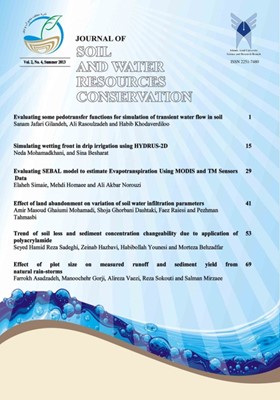Evaluating SEBAL model to estimate evapotranspiration using MODIS and TM sensors data
Subject Areas : Farm water management with the aim of improving irrigation management indicatorsElaheh Simaie 1 , Mehdi Homaee 2 , Ali Akbar Norouzi 3
1 - M.Sc. Student; Department of Soil Science; Tarbiat Modares University; Tehran 14115-336; Iran
2 - Professor; Department of Soil Science; Tarbiat Modares University; Tehran 14115-336; Iran
3 - Assistant Professor; Soil Conservation and Watershed Management Research Institute (SCWMRI);
Tehran 14115-336; Iran
Keywords: Evapotranspiration, MODIS, SEBAL, TM,
Abstract :
Accurate estimation of evapotranspiration is crucial for optimal conservation of soil and water resources in arid and semi-arid regions. Evapotranspiration is an important component of water balance in arid and semi-arid regions. The objective of this study was to evaluate SEBAL model to estimate ETa in a semi-arid area. The study was carried out in Zanjanrood watershed, Zanjan province, which is dominated by both irrigated and rainfed wheat cultivation. Using MODIS (Terra/Aqua) and TM (Landsat-5) satellite data, the feasibility of using SEBAL model with multi sensors data was investigated from June to July 2007. The estimated daily ETa values which were later obtained by SEBAL model were evaluated based on the two real evaporation pan data. The statistical results indicated that SEBAL model has reasonable potential to estimate ETa of irrigated (RMSE= 0.49 to 1.25) and dryland (RMSE= 1.3 to 2.48) wheat fields. The SEBAL model evaluates ETa of irrigated wheat field more accurate than dryland wheat field. The results further indicated that the TM images are 2.5 times more accurate than MODIS images. Furthermore, it can be concluded that the TM sensor located at Landsat satellite can better predict the ETa values than the MODIS sensor located at Terra satellite sensor in the studied area.


